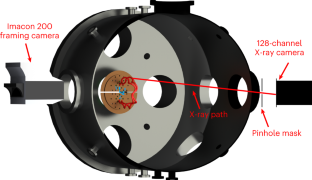2023-04-06 カリフォルニア工科大学(Caltech)
太陽フレアがエネルギー粒子やX線バーストを生成することは長い間知られていましたが、科学者たちはそのメカニズムをまだ理解し始めたばかりです。
研究者たちは、実験室で太陽コロナループをシミュレーションすることにより、この現象を調べました。
カリフォルニア工科大学のポール・ベラン教授は、キャパシタにエネルギーを充電し、そのエネルギーを電極を介して放電させることで、ミニチュア太陽コロナループを作り出しました。それぞれのループは約10マイクロ秒持続し、長さは約20cmで直径は約1cmです。
研究者たちは、太陽フレアと結び付いたエネルギー粒子やX線バーストの発生に関連する特定の構造を発見しました。それによると、プラズマループは、大きなロープに似たフラクタルなブレードストランドで構成されていることがわかりました。この構造は、X線バーストの発生に重要な役割を果たします。
<関連情報>
- https://www.caltech.edu/about/news/laboratory-solar-flares-reveal-clues-to-mechanism-behind-bursts-of-high-energy-particles
- https://www.nature.com/articles/s41550-023-01941-x
多重編組プラズマループからの実験用ナノフレアの生成 Generation of laboratory nanoflares from multiple braided plasma loops
Yang Zhang,Seth Pree & Paul M. Bellan
Nature Astronomy Published:06 April 2023
DOI:https://doi.org/10.1038/s41550-023-01941-x

Abstract
Solar flares are intense bursts of electromagnetic radiation accompanied by energetic particles and hard X-rays. They occur when magnetic flux loops erupt in the solar atmosphere. Solar observations detect energetic particles and hard X-rays but cannot reveal the generating mechanism because the particle acceleration happens at a scale smaller than the observation resolution. Thus, details of the cross-scale physics that explain the generation of energetic particles and hard X-rays remain a mystery. Here, we present observations from a laboratory experiment that simulates solar coronal loop physics. Transient, localized 7.6-keV X-ray bursts and a several-kilovolt voltage spike are observed in braided magnetic flux ropes of a 2-eV plasma when the braid strand radius is choked down to be at the kinetic scale by either magnetohydrodynamic (MHD) kink or magnetic Rayleigh–Taylor instabilities. This sequence of observations reveals a cross-scale coupling from MHD to non-MHD physics that is likely responsible for generating solar energetic particles and X-ray bursts. All the essential components of this mechanism have been separately observed in the solar corona.



